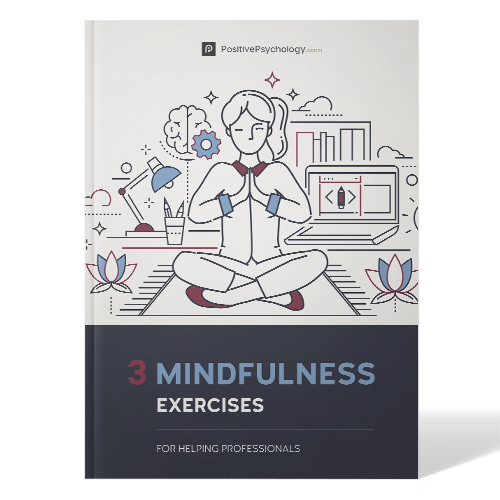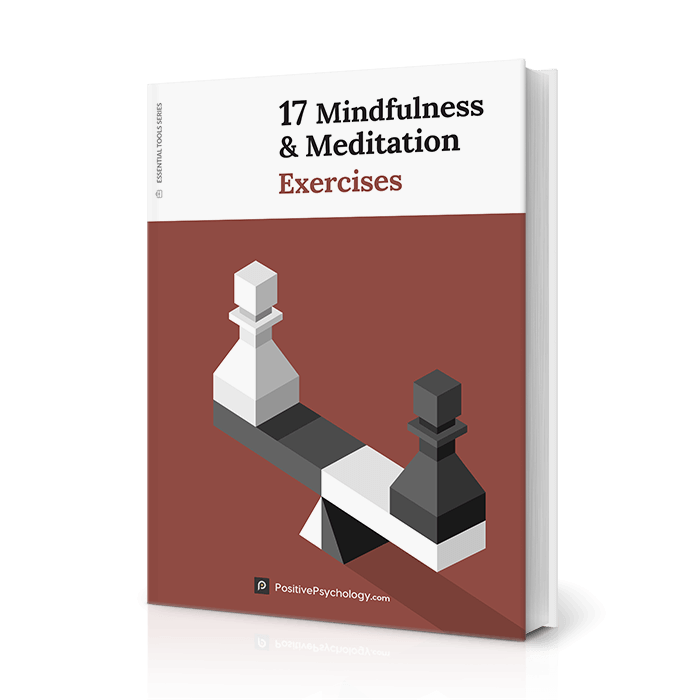What Is Compassion Meditation? (+ Mantras and Scripts)
 In positive psychology, compassion is seen as a way to relate to the self and a pathway to happiness.
In positive psychology, compassion is seen as a way to relate to the self and a pathway to happiness.
The proven benefits of compassion range from increased well-being, to relief from illness, and improved relationships.
If you want others to be happy, practice compassion. If you want to be happy, practice compassion.
Dalai Lama
The above quote is an important piece of wisdom from one of the world’s foremost spiritual leaders. A fundamental belief in Buddhism is that the road to happiness is the development of inner peace and compassion, through reflection and the training of one’s own mind. One way to cultivate this is through the ancient practice of compassion meditation.
Continue reading to learn the many proven benefits of compassion meditation and how to practice it, as well as apps, exercises, and scripts to help you get started with your practice.
Before you continue, we thought you might like to download our three Mindfulness Exercises for free. These science-based, comprehensive exercises will not only help you cultivate a sense of inner peace throughout your daily life, but will also give you the tools to enhance the mindfulness of your clients, students, or employees.
This Article Contains:
- What Is Compassion Meditation?
- Research and Studies
- 6 Proven Benefits of a Compassion-Based Practice
- Instructions on How to Best Practice Compassion Meditation
- Using Compassion and Loving-Kindness Meditations as Interventions
- 3 Guided Meditation Scripts and Exercises for Compassion
- 3 Compassion Mantras
- A Look at the Great Compassion Mantra
- What Is Compassion Yoga?
- 3 Compassion Meditation Training Apps
- 4 Recommended YouTube Videos
- A Take-Home Message
- References
What Is Compassion Meditation?
Compassion is defined as deep, genuine sympathy for those who are suffering, together with the desire to help alleviate this suffering.
Compassion meditation is a technique we can use to dissolve self-centeredness and isolation and to cultivate compassion by realizing that we are not alone in our experience of suffering.
Whereas other types of mindfulness meditation encourage nonjudgmental awareness of experiences in the present moment by focusing on bodily or other sensorial experience, affective states, thoughts, or images, [compassion meditation] focuses awareness upon alleviation of the suffering of all sentient beings.
Hofmann, Grossman, & Hinton, 2011, p. 1127
Known also as karuna meditation, compassion meditation is deeply rooted in Buddhist philosophy and guides participants toward compassionate thoughts.
It is a method for connecting with suffering — our own as well as others’ — and for awakening the compassion that is inherent in all of us.
The premise of this practice is such that if life involves unavoidable suffering, we ought to embrace it and be compassionate toward the suffering of ourselves and others.
The practice encourages us to discover our own humanness and to accept it.
Loving-kindness and compassion
The term compassion meditation is sometimes used interchangeably with loving-kindness meditation (LKM), which helps to develop the mental habit of selfless or altruistic love, encouraging the meditator to understand and accept themselves and others.
Whereas compassion meditation (CM) aims to alleviate suffering, the objective of LKM is to send out unconditional, inclusive love.
Both types of meditation are geared toward enhancing unconditional, positive emotional states. While loving-kindness practice cultivates unconditional friendliness, compassion meditation is concerned with alleviating suffering. They are strongly related because when loving-kindness is expressed toward our own or others’ suffering, compassion arises. Both are associated with an increase in positive affect and a decrease in negative affect (Hofmann et al., 2011).
(In many Buddhist practices and psychological studies, LKM and CM are combined together. The main focus of this article will be compassion meditation, though we will touch on both.)
The mental qualities of compassion and loving-kindness are two of Buddhism’s Four Sublime States. The Buddha urged people to cultivate these sublime states as habitual states of mind, in order to create the best possible relationship with the world and everyone in it (Hofmann et al., 2011):
- Loving-kindness (metta)
- Compassion (karuna)
- Appreciative joy (mudita)
- Equanimity (upekkha)
Though CM and LKM originate from Buddhist tradition, they can be adapted and practiced by anyone, regardless of religious affiliation.
In a typical loving-kindness meditation, you or your guide will direct your attention to your breath as you mentally recite suggested traditional phrases of loving-kindness, as outlined below.
Receiving loving-kindness
For this meditation, you should always begin with yourself because compassion for others begins with kindness to ourselves. You can’t extend compassion to others until you can be compassionate with your own mind. Later, you will expand that loving-kindness outwardly to loved ones, strangers, and even people whom you might not like very much.
As you say each phrase in your mind, see if you can imagine breathing warmth and compassion into your heart space, then breathing out warmth and compassion toward yourself, allowing the compassion to permeate your body.
The most widely utilized script for LKM is simple and concise, but powerful:
May I be happy.
May I be peaceful.
May I be free from suffering.
Here are some more suggestions of traditional phrases that you may use during your loving-kindness meditation, in any combination that you see fit:
May I be filled with loving-kindness.
May I be safe from inner and outer dangers.
May I be well in body and mind.
May I be at ease and happy.
May I walk in peace.
Once you have chosen your script, you repeat these phrases over and over in your mind as you would with a mantra in other forms of meditation, while breathing warmth and compassion in and out from your heart space.
Once you’ve done so a few times and feel ready to move on, you will then direct your wishes of loving-kindness toward someone that you love very much.
Sending loving-kindness to loved ones
Now that you have received loving-kindness yourself, you can extend these warm wishes toward a friend or loved one:
May you be happy.
May you be peaceful.
May you be free from suffering.
This time you are picturing your loved one and sending all your love and warmth to that person. That person and you are alike. Just like you, that person wishes to have a good life.
Repeat your script over in your mind a few times until you feel ready to move on to another loved one, and so on. You can decide how many times you wish to repeat this process.
Sending loving-kindness to neutral people
Next, think of an acquaintance or someone you don’t know very well. You should not have any particular feeling toward this person. You and this person are alike in your wish to have a good life.
Send all your wishes for well-being to that person, repeating your script while breathing warmth and compassion from your heart space.
Sending loving-kindness to a difficult person in your life
Finally, it’s time to direct loving-kindness toward an enemy or someone you actively have conflict with. Your wish is that they too might be filled with loving-kindness and peace.
It will take practice, but as your heart opens up, you may begin to find that you won’t want to close it anymore.
You can find many variations of how to practice loving-kindness meditation, but it’s important to follow your heart and do whatever feels right to you, in that moment. As long as you are sending out loving-kindness to someone, even if just to yourself, in the beginning, you’re on the right track!
Tonglen meditation
Compassion meditation is essentially tonglen – an ancient spiritual method of cultivating compassion for all sentient beings, thus cultivating a direct healing experience within one’s own mind.
Originating from Tibetan Buddhism, the word tonglen is Tibetan for “giving and taking” (or sending and receiving). It involves the use of visualization to awaken compassion and become liberated from age-old patterns of selfishness.
To practice tonglen, one visualizes themselves taking in the suffering of others on the in-breath, and on the out-breath, sending out relief.
We breathe in feelings that we would generally hope to get rid of, and we breathe out that which we find pleasurable and that we usually grasp for and cling to for dear life.
It is common for people to worry that they are absorbing the suffering or negative energy of others, but this is not the case. In practicing tonglen or compassion meditation, you are simply using your breath to acknowledge dark emotional states, and visualizing that suffering transforming into love and compassion.
By reversing the logic of avoiding suffering and seeking pleasure, we begin to break down the habitual pattern of selfishness, introducing us to a far larger view of reality. This helps us move from judgment, isolation, and ignorance, to caring, connection, and understanding.
Tonglen is a method for overcoming our fear of suffering and for dissolving the tightness of our hearts. Primarily it is a method for awakening the compassion that is inherent in all of us, no matter how cruel or cold we might seem to be.
Chödrön, 2018
Tonglen can be done either as a formal meditation practice or right on the spot at any time. Later we will outline specific instructions on how best to practice this compassion meditation.
Research and Studies

Now, even further research is being made into the lesser-known but increasingly popular compassion-based practices and how they affect the brain systems involved in empathy.
This growing body of research suggests that compassion-based meditation practices can lead to mood improvements, stress reduction, better relationships, and perhaps most obviously, increased empathy and compassion.
Here is a look at a few different studies and their findings on compassion meditation.
Study #1
A 2008 study from the University of Wisconsin–Madison used functional magnetic resonance imaging (or fMRI scans) to investigate the brain circuitry of people with extensive experience practicing compassion meditation.
This was the first ever study to use fMRI scans to indicate that positive emotions such as compassion and loving-kindness can be learned, in the same way as learning to play a musical instrument.
The study revealed that brain circuits used to detect emotions and feelings were dramatically changed in subjects who had extensive experience practicing compassion meditation.
During the study, 32 subjects (16 Tibetan monks with minimum 10,000 hours of meditation experience, and 16 age-matched controls who were taught the fundamentals of compassion meditation two weeks before the brain scanning took place) were exposed to negative and positive human vocalizations designed to evoke empathic responses.
The scans revealed significant activity in the insula — a region near the frontal portion of the brain that plays a key role in bodily representations of emotion — when the long-term meditators were generating compassion and were exposed to emotional vocalizations.
The strength of insula activation was also associated with the intensity of the meditation as assessed by the participants (Land, 2008).
Study #2
Recent studies from 2017 found that different types of meditation alter the brain differently. During a nine-month meditation program conducted by the Max Planck Institute of Human Cognitive and Brain Sciences in Germany, 300 participants practiced three different kinds of meditation, in three-month blocks.
Each mediation had a particular focus, such as improving compassion, attention, or cognitive skills. Using a number of different approaches including MRI, researchers found significant brain alterations during each three-month block.
In one part of the study, participants were asked to respond to a stressful situation like a job interview or school exam. Interestingly, those who were practicing compassion-based meditations showed levels of the stress hormone cortisol 51% lower than the subjects who partook in other types of mediation (Ratner, 2017).
Study #3
A 2015 study from Brazil found that practicing yoga along with compassion meditation three times a week for eight weeks improved quality of life, attention, and self-compassion among family caregivers of patients with Alzheimer’s disease.
46 participants were divided into two groups: those participating in the 8-week compassion meditation program, and those in the control group. The program was comprised of three yoga and meditation practices per week, each lasting an hour and 15 minutes.
The meditators showed statistically significant improvements (P < 0.05) on quality of life, attention, vitality and self-compassion scores as compared with the control group, which showed no significant differences (Danucalov, Kozasa, Afonso, Galduroz, & Leite, 2015).
Study #4
A 2005 study from Duke University Medical Center tested an 8-week loving-kindness meditation program for chronic low back pain patients.
The rationale for testing LKM in this population is that it may help produce an affective shift from a greater predominance toward negative emotions to a greater predominance toward positive emotions.
Examples of negative emotions being anger, sadness and anxiety, and positive emotions such as love and joy. The study randomly assigned 43 patients to either the LKM program or to standard care.
The findings showed significant improvements in pain and psychological distress in the group that practiced loving-kindness but did not find any changes in the standard care group.
Furthermore, daily data showed that an increase in loving-kindness practice on any given day was related to a decrease in pain that day, as well as a lower incidence of anger the next day.
Given that theories of pain support that negative emotions can increase pain and conversely positive emotions can decrease pain, a positive affective shift of this kind could be crucial for chronic low back pain sufferers (Carson et al., 2005).
6 Proven Benefits of a Compassion-Based Practice
Research supports that meditation, in general, can reshape neural pathways linked to compassion, helping meditators to see the interconnectedness of all human suffering.
Taking this a step further, compassion and loving-kindness meditation specifically aim to cultivate a sense of altruism and warm-heartedness towards our fellow man; and the more we care about the wellbeing of others, the greater our own sense of wellbeing becomes.
Moreover, when we practice tonglen with the intention for others — sending blessings, strength, happiness, and freedom from pain — our mind gets to experience these positive states first.
Compassion has the effect of putting the mind at ease, helping to alleviate fears and insecurities, giving us the strength to cope with obstacles in everyday life.
In fact, compassion is considered such a vital quality that there is now a form of psychotherapy called Compassion-Focused Therapy, which emphasizes the importance of applying compassion for living a healthy and happy life.
The proven benefits of a compassion-based meditation practice range from increased well-being, to relief from illness, and improved emotional intelligence.
Below we list some of the many benefits that this transformative meditation practice can have on one’s mind, body, soul, and relationships.
Cultivate compassion
Perhaps the most obvious benefit of a compassion-based practice is that it cultivates love, empathy, and benevolence, motivating altruistic behavior in the meditator.
It helps us realize that “individual me” and “individual you” are mistaken ideas, as suffering is universal. Regular practice activates and strengthens areas of the brain responsible for empathy and emotional intelligence.
Betterment of relationships
Compassion enables us to understand ourselves and others better, which is important in all relationships.
Practicing compassion also helps us to mend relationships as it increases our capacity for forgiveness as well as our connection to others while decreasing anger and our bias toward others.
Reduce symptoms of major disorders
Compassion meditation has been proven to reduce symptoms of post-traumatic stress disorder, as well as negative symptoms in those with schizophrenia-spectrum disorders.
Compassion meditators with schizophrenia-spectrum disorders have also shown increased positive emotions and psychological recovery (Johnson et al., 2011).
Decrease in depression & stress
Compassion-based practices are said to reduce stress as well as depression, as they focus on creating an attitude of acceptance, love, and kindness towards oneself and others (Gardner, 2018).
Moreover, by temporarily shifting your attention away from your own challenges and focusing on the suffering of others, it helps put things into perspective.
Quiet the mind
Distinct from other forms of meditation, compassion-based practices involve focusing one’s attention on a particular person or benevolent phrase, as opposed to having no specific object of contemplation.
Therefore LKM and compassion meditation practices decrease the tendency for the mind to wander, helping to diminish negative physiological effects like anxiety and fear, while increasing one’s ability to attend to important tasks.
Alleviate chronic pain
There are multiple associations between mental health and chronic physical conditions that significantly impact people’s quality of life.
Preliminary studies suggest that a compassion-based practice can be beneficial in reducing persistent lower back pain (Carson et al., 2005), and it has also been proven to help reduce migraine pain and alleviate emotional tension associated with chronic migraines (Tonelli & Wachholtz, 2014).
Instructions on How to Best Practice Compassion Meditation

A useful starting point is to practice for a few moments at a time, and gradually increase the length of your meditation over time. Below are some instructions and tips on how to best practice compassion meditation, and the stages it is comprised of.
Expect nothing in return
When you practice loving-kindness or compassion meditation, it’s important that you give without expecting anything in return.
True love, according to Zen Buddhism, is the wish for others to be happy without expecting anything in return from them; it is altruistic and without conditions. You will undoubtedly get something out of a compassion-based practice, but it should not be expected.
Systematic approach
Compassion-based meditation practices take a systematic approach that helps meditators to build up their compassion “muscle” in a similar way that one would work up to heavier weights in a gym — the lightest weight being a loved one, and the heaviest weight being a very difficult person in our life (some might say an enemy).
In other words, it is suggested to start tonglen with situations where it’s fairly easy. The practice becomes more challenging when you start to do it for people who you don’t know, and even more challenging when you do it for people who you don’t like.
First, the meditator will practice “sending and receiving” with the thought of a loved one in mind; then they should practice compassion for themselves; then for a stranger; and finally, they should practice sending and receiving for someone they actively have friction with.
One may begin by first directing compassion toward oneself or toward a loved one; whichever is easiest for the individual.
A simple way to begin meditating with tonglen is to envision whatever personal pain or suffering you might be dealing with at that time in your life, and think to yourself, “other people feel this too.”
It begins with the realization that there are millions of others just like you, who at that very moment are feeling the same pain or sadness.
So you breathe in the pain and suffering of all those people who are dealing with that same emotion, and you breathe out relief, or “space” for sufferers’ hearts and minds to be able to live with their discomfort, fear, anguish, etc.
Formal vs informal practice – Tonglen on the spot
We often associate meditation with the formal practice — sitting down with our eyes closed to focus on our breath — but we can also learn to practice meditation during those fleeting moments of discomfort we experience throughout the day.
In terms of compassion meditation, this is known as “tonglen on the spot.”
Whenever you are met with a situation that is difficult or painful for you, you can begin the practice of tonglen — giving and taking, sending and receiving.
Unlike the formal practice, it doesn’t involve visualization or steps. It is simple and direct: you see suffering, you take it in with the in-breath, and send out relief with the out-breath.
Another opportunity for tonglen on the spot is when you feel you are lacking or having a hard time finding compassion or openness in a particular situation.
Using Compassion and Loving-Kindness Meditations as Interventions
Compassion meditation has become increasingly popular as a contemporary treatment for everything from chronic pain to negative body image, as studies indicate that compassion-based practices help reduce stress-induced subjective distress and immune response (Hofmann et al., 2011).
Compassion intervention has proven useful in reducing pain severity and anger, as well as increasing chronic pain acceptance.
Loving-kindness and compassion meditation have also been used as an intervention for body image issues in women lacking self-compassion, with results indicating significantly decreased body dissatisfaction among participants.
Compassion meditation is now also being used as a tool to improve healthcare provider compassion, resilience, and patient care.
There are many other possible applications of this type of compassion training that are just starting to be explored. Compassion-based meditation practices can be brought into schools, for example, helping kids to be more attuned to their emotions as well as those of other children, which could potentially decrease bullying.
Compassion intervention may also benefit individuals who experience social challenges such as social anxiety or antisocial behavior. Overall the wellness community is excited about the healing qualities of this powerful practice and the prospect of compassion meditation to help the general population.
3 Guided Meditation Scripts and Exercises for Compassion

Script/Exercise #1
Below we’ve come up with a simple exercise for practicing tonglen compassion meditation — consciously breathing in the suffering of others, and breathing out relief for that suffering.
- Find a comfortable position and begin to follow your breath and quiet the mind. After a few minutes or once you are relaxed, you can bring to mind a friend or loved one whom you know is experiencing emotional discomfort or suffering. Imagine that he or she is standing in front of you, and visualize their suffering as a dark, heavy cloud surrounding him or her.
- Move your awareness to your heart area and breathe in deeply, imagining yourself inhaling those dark, heavy, uncomfortable, cloudy feelings, directly into your heart. As you breathe out from the heart area, imagine that your heart is a source of bright, warm, compassionate light, and you are breathing that light into the person who is suffering. Imagine that the dark feelings are disappearing without a trace into the light of your heart; the dark clouds transforming into a bright, warm light at the center of your heart, alleviating his or her suffering.
- Next, try extending your compassion out to a stranger or general population that may be experiencing dark, heavy feelings at this moment. As you did for your loved one, imagine inhaling these cloudy, dark feelings away from those people into your own heart. As the dark feelings settle into your heart, imagine that they are disappearing without a trace into the light of your compassionate heart. You can imagine this person or people being enveloped by the calm and comforting light that you are breathing out from your heart.
- Continue the above process of sending and receiving, but this time extend your compassion out to someone you find difficult to associate with. Tonglen can extend infinitely, and the more you practice, the more your compassion will expand naturally. You might be surprised to find that you are more tolerant and able to be there for people even in situations where it used to seem impossible.
Some instructions for tonglen meditation will guide the meditator to practice tonglen on themselves, while others will not. It’s important to remember, however, that self-compassion is the key to becoming a more compassionate person overall.
Script/Exercise #2:
Next, we have a tonglen compassion meditation script from a senior teacher in the Shambhala Buddhist tradition, Ethan Nichtern (2014).
Begin by setting your intention to invite suffering in and to remain present with it. Settle the mind and ground yourself with some mindfulness of breath for a few minutes, and then you will begin the four steps of tonglen.
1. (Approximately 3 minutes)
Envision yourself in a safe space. You will be taking in feelings such as grief, anger, and anxiety, so it’s important that you feel comfortable where you are. Remember that if anything comes up that you don’t feel able to handle in that moment, you may simply return to your breath and take a more relaxed approach to the practice.
Take a minute or two to try and quiet the chatter in your mind, simply observing, and tuning in to your own awareness. Remain open and observant of your surrounding environment.
For another minute or two, try to connect with a sense of compassion. To do so, you might bring your attention to the softness of your heartbeat, or evoke a memory that hits your “soft spot,” making you feel tender in an energized and interconnected sense.
Do not try to recall a memory that provokes fear or personal shame.
2. (Approximately 3 minutes)
Bring your awareness back to your breath, and as you inhale, begin visualizing pollution entering your body — smoke, dark clouds, or just a general feeling of obstruction and darkness.
In a state of open awareness, this negativity will have nowhere to “stick” in your body (you might imagine your body as not really solid but made of a light substance), therefore allowing it to be processed and transformed.
As you exhale, imagine you are breathing out bright, pure, nourishing air, as though your body is a plant, receiving pollution and sending out clean energy.
If your mind wanders, come back to your breath and the textural rhythm of giving and taking.
3. (Approximately 10 minutes)
Step 3 represents the bulk of your meditation practice, where you actively bring to mind the different recipients of your compassion.
Nichtern recommends starting with yourself, and then moving on to your other recipients — people you know are having a hard time.
You might wish to bring a list of people with you, or to practice more spontaneously, working with whoever arises in your mind. You can spend a few minutes of meditation on each person, including yourself.
4. (Approximately 3–5 minutes)
Now as you continue with this cycle of inhaling and exhaling suffering and relief, begin to visualize suffering beyond any individual person.
You might expand spatially, outwardly from your body: people who live on your block, in your neighborhood, in your city, and so on. You could also expand to particular groups of people who may be suffering, such as your family, a particular community, or an impoverished country.
Whichever way you choose, allow the size of the group to gradually expand until you are taking in suffering from any and all directions, and breathing out healing and relief in all directions as well.
Now you may return to resting in open awareness for several minutes or as long as you wish. Follow the breath and on the exhale, release any tension that may have arisen during the meditation.
Continue with a few deep breaths or even sighs if it feels good to do so. Relax and let go, arriving in the present moment.
Script/Exercise #3:
Tonglen can also be practiced informally and on the spot as one bears witness to suffering in everyday life. Here Nichtern (2014) outlines how to practice tonglen on the spot.
At any point during the day when you experience personal suffering or observe someone else who is suffering or struggling, you can do tonglen for one to three breaths.
For example, if you see a mother struggling with an unruly child, you might wish to breathe in the stress and anxiety of the mother and breathe out a sense of calm and ease.
You could also practice tonglen for the child in this situation, breathing in the child’s discomfort and breathing out love and relief. If you see two people yelling at each other, you can breathe in the argument and breathe out understanding.
Likewise, you can practice tonglen for yourself if someone has upset you or something bad has happened.
This can be practiced as quickly as one cycle of breath or you could do it for longer. There’s no need to completely stop whatever you’re doing, just simply put enough energy into staying present with the suffering, without over analyzing or judging it.
Nichtern (2014) attests that practicing tonglen on the spot even just three times a day builds the compassion “muscle” in a truly transformative way.
If you enjoyed these, we also have another article offering three guided meditation scripts.
3 Compassion Mantras
A mantra is a sacred sound, vibration, word, or group of words, uttered in Sanskrit and believed to have spiritual and psychological powers. Mantra is the basis of all wisdom traditions, prayers, and scriptures.
Spoken, chanted, or recited mentally, mantras can help alter subconscious impulses, habits, and afflictions, and are also used to enter a deep state of meditation. Mantras should be practiced on a regular basis in order for their desired effects to take place.
A “compassion mantra” is one which is used to express compassion, peace, gratitude, and devotion. Here are some of the most well-known compassion mantras around the world (Bonta, 2017):
1. Compassion Buddha mantra
“Om Mani Padme Hum” is the most well-known mantra in Tibetan Buddhism. Known as the compassion Buddha mantra, it translates in English to “the jewel is in the lotus.”
However, the literal interpretation is poor, as the mantra means much more than the translation depicts. This chant is said to calm fears, alleviate worries, and heal broken hearts; until the chanter is pure, compassionate, and wise as the lotus flower itself.
2. Happiness and freedom mantra
“Lokah Samastah Sukhino Bhavantu” is a compassion or loving-kindness mantra that translates to: “May all beings everywhere be happy and free, and may the thoughts, words, and actions of my own life contribute in some way to that happiness and to that freedom for all.”
This mantra promotes compassion and living in harmony with all sentient beings.
3. Medicine Buddha mantra
“Tayata Om Bekanze Bekanze Maha Bekanze Radza Samudgate Soha” is a mantra that is said to promote success and help to eliminate obstacles and suffering for all sentient beings.
It’s known to be extremely powerful for healing physical illnesses and purifying negative karma.
A Look at the Great Compassion Mantra

In Sanskrit, the ancient language of yoga, the great compassion mantra is called Maha Karuna Dharani or Nilakantha Dharani, and also known as Da Bei Zhou.
Though it is most often sung or spoken in the original Sanskrit, this lengthy sacred text (typically consisting of 84 lines) has been translated to a multitude of different languages, including Chinese, Korean, Japanese, Vietnamese, Thai, and English.
As with most Sanskrit mantras, however, the translation of the words is just one level of meaning. Mantras are also valued for their sound vibrations — in many cases even more so than the actual meaning of the words.
Said to be among the most beautiful mantras to listen to, both in tonality and expression, the great compassion mantra is sung daily by many devoted followers of the Compassionate Buddha. It is meant to transform us at a more profound level than can be conveyed with simple words (Kane, n.d.).
They will always meet good friends.
They will always be born in a good country.
They will always be born at a good time.
Their place of birth will always have a good king.
Their family will be kind and harmonious.
Their heart will be pure and full in the way.
They will not violate the prohibitive precepts.
The organs of their body will always be complete.
They will obtain everything they seek.
They will always obtain the help and respect of others.
Their riches will not be plundered.
They will always have the necessary goods and wealth in abundance.
In the place where they are born, they will see the Buddha and hear the Dharma.
Dragons, gods, and good spirits will always protect them.
They will awaken to the profound meaning of that Proper Dharma which they hear.
What Is Compassion Yoga?
The practice of yoga is one of the best methods for exploring and strengthening self-compassion. Self-compassion is not merely a state of being, rather, self-compassion is a practice, and we cultivate it through experience.
During all forms of yoga, including asana (the physical component which consists of postures/poses), pranayama (breathwork), and meditation, we learn nonjudgmental awareness and acceptance of our reality in any given moment.
Working with uncomfortable poses teaches us about resistance to suffering and how to deal with discomfort; cultivating courage, presence, and compassion, through tolerating the discomfort.
Yoga for compassion is simply bringing a loving, compassionate attitude and intention to your yoga mat. In a similar way to practicing compassion-based meditation, compassion yoga involves bringing awareness to the physical sensations around the heart, and connecting/dedicating feelings of loving-kindness and compassion to your practice/movement.
3 Compassion Meditation Training Apps
- Meditation Studio offers meditations to cultivate compassion, guiding you to reconnect with yourself, others in your life, and around the world. The app has 16 meditations that comprise the “Compassion Collection,” which brings together a number of heartfelt-guided meditations that focus on loving-kindness, healing the heart, forgiveness, and unconditional love.
- The popular Headspace app helps us to “rediscover kindness” in an informative and delightful manner. The app takes us through The Loving-Kindness technique, The Sunlight Visualization technique, and Skilful Compassion Visualization, in which we place the happiness of others before our own.
- InsightTimer offers the largest free library of guided meditations in the world, with renowned teachers such as Sharon Salzberg. Here you will find over 500 guided meditations, music tracks, and talks about compassion.
4 Recommended YouTube Videos
A short selection of excellent videos on the subject.
Matthieu Ricard Leads a Meditation on Altruistic Love and Compassion | Talks at Google
In this 39-minute video, Buddhist monk Matthieu Ricard introduces the concept of meditation and mindful breathing, leads a guided meditation that includes compassion and altruistic love, and ends with a Q&A portion.
Ricard is an active participant in the current scientific research of the effects of meditation on the brain, and is known as an excellent bridge between modern science and ancient wisdom.
A Tonglen Meditation Practice for Sending and Receiving Compassion
This 21-minute guided tonglen meditation is for more advanced meditators, as tonglen is not recommended for those brand new to meditation.
The video posted by Live Sonima features a guide with a very clear and calming voice, encouraging an opening of the heart and offering of empathetic aspirations. This meditation is an excellent combination of descriptive instruction, and space for the meditator to go deeper.
#30 Pema Chodron – Tonglen Meditation
In this 48-minute video, world-renowned author and Buddhist nun, Pema Chödrön, introduces us to tonglen meditation and a few of its styles — including taking a tonglen attitude toward pleasure and pain whenever it arises in your life — as well as some difficulties you might experience in practice.
Then Pema takes us through a guided experience of tonglen for about 13 minutes (beginning at 33 minutes).
Loving Kindness Meditation to Develop Mindfulness and Compassion
This is a simple, guided loving-kindness meditation to develop mindfulness and compassion.
The guide from WiseMindBody uses a very calming tone of voice in this 13-minute video, guiding us very simply through a standard LKM practice — directing loving-kindness toward oneself, then toward our loved ones, acquaintances, someone we have a conflict with, and finally, toward the entire human race.
A Take-Home Message
Research continues to reveal that compassion is much more than just a concern for the suffering of others. It is a valuable skill that can be cultivated over time through such practices as loving-kindness and compassion meditation.
Compassion-based practices create a clear path to peace and happiness, teaching us to forgive, accept, and love ourselves and one another.
The transformative effect is distinct from other spiritual practices, with its benefits and psychological interventions being explored and applied globally.
Instead of beating yourself and getting lost in your suffering, compassion meditation offers a way to use your own suffering as a tool for true insight and understanding into what people all over the world are going through.
Utilize your personal suffering as the path to compassion for all human beings, one breathe at a time, and watch your life transform.
We hope you enjoyed reading this article. Don’t forget to download our three Mindfulness Exercises for free.
- Bonta, F. (2017, September 1). 7 Mantras for creating the life you want. Retrieved from https://www.karmalifestyle.com/blogs/news/7-mantras-for-creating-the-life-you-want
- Carson, J. W., Keefe, F. J., Lynch, T. R., Carson, K. M., Goli, V., Fras, A. M., & Thorp, S. R. (2005). Loving-kindness meditation for chronic low back pain: Results from a pilot trial. Journal of Holistic Nursing, 23(3), 287-304.
- Chödrön, P. (2002). Tonglen on the spot. Retrieved from https://tricycle.org/magazine/tonglen-spot/
- Chödrön, P. (2018, January 11). Transforming the heart of suffering. Retrieved from https://www.lionsroar.com/transforming-the-heart-of-suffering/
- Danucalov, M. A., Kozasa, E. H., Afonso, R. F., Galduroz, J. C., & Leite, J. R. (2017). Yoga and compassion meditation program improve quality of life and self-compassion in family caregivers of A lzheimer’s disease patients: A randomized controlled trial. Geriatrics & Gerontology International, 17(1), 85-91.
- Gardner, A. (2018, June 26). 11 Types of meditation that can help treat depression. Retrieved from https://www.health.com/condition/depression/types-of-meditation-for-depression
- Hofmann, S. G., Grossman, P., & Hinton, D. E. (2011). Loving-kindness and compassion meditation: Potential for psychological interventions. Clinical Psychology Review, 31(7), 1126-1132.
- Johnson, D. P., Penn, D. L., Fredrickson, B. L., Kring, A. M., Meyer, P. S., Catalino, L. I., & Brantley, M. (2011). A pilot study of loving-kindness meditation for the negative symptoms of schizophrenia. Schizophrenia Research, 129(2-3), 137-140.
- Kane, L. (n.d.). Great compassion mantra: Purification, healing and protection, the Maha Karuna Dharani Sutra — benefiting all beings. Retrieved from https://buddhaweekly.com/great-compassion-mantra-purification-healing-protection-maha-karuna-dharani-sutra-benefiting-beings/
- Land, D. (2008, March 25). Study shows compassion meditation changes the brain. Retrieved from https://news.wisc.edu/study-shows-compassion-meditation-changes-the-brain/
- Nichtern, E. (2014, June 30). Tonglen in with the bad, out with the good. Lion’s Roar. Retrieved from https://www.lionsroar.com/tonglen-in-with-the-bad-out-with-the-good-your-guide-to-buddhist-meditationjuly-2014/
- Parks, S., Birtel, M. D., & Crisp, R. J. (2014). Evidence that a brief meditation exercise can reduce prejudice toward homeless people. Social Psychology, 45, 458-465.
- Ratner, P. (2017, October 10). Scientists discover how meditation changes the brain. Big Think. Retrieved from https://bigthink.com/paul-ratner/scientists-discover-how-meditation-changes-the-brain
- Tonelli, M. E., & Wachholtz, A. B. (2014). Meditation-based treatment yielding immediate relief for meditation-naïve migraineurs. Pain Management Nursing, 15(1), 36-40.
Let us know your thoughts
Read other articles by their category
- Body & Brain (49)
- Coaching & Application (57)
- Compassion (26)
- Counseling (51)
- Emotional Intelligence (24)
- Gratitude (18)
- Grief & Bereavement (21)
- Happiness & SWB (40)
- Meaning & Values (26)
- Meditation (20)
- Mindfulness (45)
- Motivation & Goals (45)
- Optimism & Mindset (34)
- Positive CBT (28)
- Positive Communication (20)
- Positive Education (47)
- Positive Emotions (32)
- Positive Leadership (18)
- Positive Parenting (4)
- Positive Psychology (33)
- Positive Workplace (37)
- Productivity (16)
- Relationships (46)
- Resilience & Coping (36)
- Self Awareness (21)
- Self Esteem (38)
- Strengths & Virtues (31)
- Stress & Burnout Prevention (34)
- Theory & Books (46)
- Therapy Exercises (37)
- Types of Therapy (64)





What our readers think
This is a great reading tool for the mind. It is interesting and soothing to my soul.
Great job!
This is a really great and long article and it is written in very beautiful way i would love to read it again and again.
This is a great resource. Compassion and loving -kindness are at the core of intra-personal and interpersonal relationships! It will go along way to make me an effective therapist. Thanks!
The article is awesome.
What to write in respose to this articale is very difficult for me. I must say that every body must read it compessionatly and tailer it according to his own belief system and apply .i hope you will find results.
What an incredible read, rich in resources to explore! The information about emerging research into compassion-based practices is interesting and encouraging. I have been reminding myself in the last week to get back into a routine of morning meditation so this is timely and very helpful. Thank you!
I fully enjoyed this article and the resources. I feel my mission being focused on mindfulness and compassion. I didn’t realize there was something like this.
I have felt this way for a long time. Identifying with Jesus or the Dalai Lama. This is great for help in a compassion circle group for healing and cultivating practice to the world.
Thank you.
Many blessings.